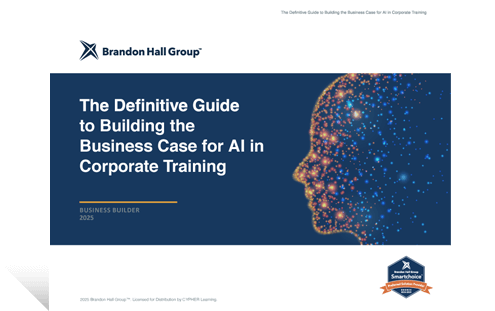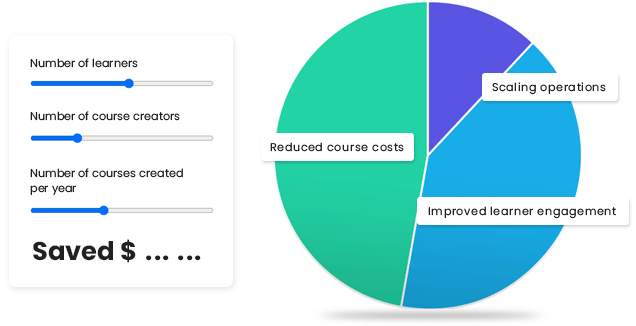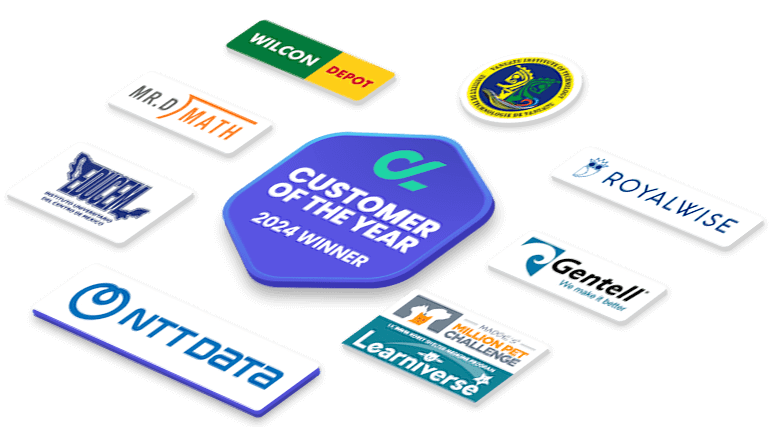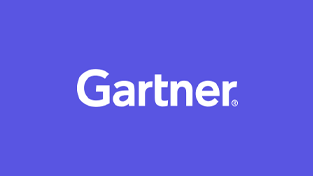AI-powered
course creation
Built for people that need courses in minutes, not months.

AI-powered
skills development
Automate the skills lifecycle with pinpoint precision.





















































Brilliant courses. In minutes.
In the industry, creating just one course takes about 430 hours—CYPHER AI 360 slashes that time down to minutes, automating everything from content creation, gamification, skills mapping, assessments, and so much more. Let CYPHER AI 360 do the heavy lifting.
In the survey: Bridging the AI digital divide, CYPHER Learning surveyed 4,543 workers, from a cross-section of industries across the US, UK and Mexico. Read the report and explore how AI is shaping the future of work.

In the guide: Building the Business Case for AI in Corporate Training, the Brandon Hall Group™ explores how AI is transforming workforce development by personalizing learning, closing skills gaps, and boosting ROI.

Easy on you. And your bottom line.
View the survey details

Training smarter starts with knowing the numbers
See how the CYPHER platform helps you save course costs, operational costs, and improve learner engagement.
Try our ROI CalculatorCustomer of the Year 2024 Winners
We are celebrating the organizations that pushed boundaries, broke records, and made learning their competitive advantage. Their stories aren’t just impressive — they’re proof that when you invest in the right partner, the results speak for themselves.
Meet the winners!
Skills mapped. With precision.
Automate your skills lifecycle with pinpoint precision. Save time, align learning with key skills, and boost employee growth. Our platform complements talent management systems, enhancing their ability to develop the right skills for success.
Customers and analysts say it best
“80-90% [of the work] in 10 minutes. It’ll just knock your socks off”
John Leh, Talented Learning
“CYPHER AI 360 was easy to use”
Australian Institute of Fitness
“The best Gen-AI for course content builder I have seen”
Craig Weiss, The Craig Weiss Group
“It will give me back countless hours”
Served with Honor
GenAI content accuracy. Double-checked.
AI Crosscheck uses another powerful AI to double-check content created by GenAI, flagging slip-ups and keeping things accurate. You’re in control—apply or skip the corrections as you see fit, and stay confident in your content.
Making headlines everywhere




























User engagement with flair and fun? Always.
Supercharge learner engagement with AI-enabled gamification, assessments, media, and 50+ language translations. Make learning more personal and memorable. Add fun and style to every learning moment.
CYPHER AI 360 FAQs
We are currently seeing an average of 5 to 10 minutes to create a comprehensive course including assessments, gamification, competency, and more. Though AI 360 can get 80% of the mundane work done in minutes, the final 20% still needs human intelligence to validate the content and overall learning experience.
If you used ChatGPT this is what you would need to do for a single course with the assumption that it would require 150 inquiries to use ChatGPT to create a course.
- Identify the 150 inquires (questions) you need to ask ChatGPT
- Ask ChatGPT 150 questions
- Consolidate all the responses
- Put the responses in a course template
- Remaining steps are manual such as formatting, gamification, assessments, skills mapping, and rubrics mapping. Not to mention you'll need to manually add and source visuals, video, and audio options.
So while useful to get base content, that is ChatGPT where it stops.
5,000+ skills/competencies are already preloaded:
- Skills / competencies for over 2,000 jobs that map to US Dole, O*NET and ESCO standards
- Skills / competencies for over 2,500 courses that map to USA, Philippines and Brazil standards
Additional skills / competencies can easily by added upon request. You can add your own as well!
Yes! Using the LTI standard, CYPHER can publish courses into any other LMS that uses LTI. This means you get more than just beautiful course content. You also get engaging and comprehensive gamification, assessments, competencies, reporting and measurement when using the CYPHER platform. See more about LTI.
Yes! We have enterprise-class integration capabilities that make it easy. See more about integrations.
As part of CYPHER AI 360, we offer AI Crosscheck, a powerful tool that reviews and flags inconsistencies in AI-generated content. It identifies errors, provides reasons for these flags, and suggests replacement text. Users can then choose to apply or ignore these suggestions, ensuring the accuracy and reliability of the content.
To help address:
- Content inaccuracy: ChatGPT-3, the generative-AI tool, “agreed with incorrect statements between 4.8 percent and 26 percent of the time, depending on the statement category.” view source
- Content bias: USC researchers find bias in up to 38.6% of ‘facts’ used by AI.
CYPHER leverages multiple paid Generative AIs to provide AI-enabled skill management and complete course creation. The distinctions between free and paid generative AI services are crucial, particularly in how they handle data. Here’s a closer look at the key differences:
- AI data usage and privacy policies: Free generative AI services often collect and use user data for service improvement and advertising, with broader data usage policies. In contrast, paid AI services offer stricter privacy policies, providing users with better data control and compliance with regulatory standards.
- AI data ownership and rights: Free AI tools often grant providers extensive rights to use and share your data, including with third parties and for training models. In contrast, paid AI services typically offer greater control over data ownership, with agreements that limit the provider's ability to use or share data without explicit user consent.
- AI security measures: Free AI services generally lack advanced security features, such as dedicated support, advanced encryption, and industry compliance. Paid AI services often provide enhanced security features, including compliance with regulations like GDPR and HIPAA, along with additional security controls and continuous monitoring.
- AI support and accountability: Free AI services typically offer limited support through community forums or basic help articles, with lower accountability for data breaches or misuse, while paid AI services provide dedicated support and clear accountability.
- AI transparency and compliance: Free AI services may lack transparency in data handling and compliance with privacy regulations, while paid AI services offer greater transparency, compliance with industry standards, and detailed data handling assurances.
Read our "Free vs. Paid AI Services: Navigating the privacy and security landscape" blog to learn more.













